If you're looking for the best ways to remove paint, there are a few things you should consider before making a decision. First and foremost, you need to identify the type of paint you are trying to remove as different types of paint require different removal methods. Also, you need to determine the surface you are working on. Some surfaces are sensitive to certain removal methods and might get damaged in the process. Another factor to consider is the level of toxicity of the remover and whether it poses a danger to your health or the environment.
When it comes to removing paint, there are several options available. One option is using heat gun or solvents, but these methods require proper ventilation and protective gear to prevent health hazards. On the other hand, some people prefer using natural remedies such as vinegar or baking soda as a safer alternative. However, these remedies might not be effective enough for tough jobs, so you need to weigh the pros and cons of each method to find the best fit for your needs.
Do you struggle with removing old paint from your walls or furniture without damaging the surface? Do you need a remover that won't pose a health hazard to you and your family? What are the best ways to remove paint from different surfaces and types of paint? All these questions and more will be covered in our in-depth guide to the best ways to remove paint. Keep reading to learn more and make an informed decision.
10 Best Ways To Remove Paint
| # | Product Image | Product Name | Product Notes | Check Price |
|---|---|---|---|---|
|
1
|
The product is ideal for scraping paint, spackling walls, removing wallpaper, and crown molding work.
|
|
||
|
2
|
Ideal for removing labels, stickers, paint, and cleaning windows and walls. Comes with adjustable handle and 20 blades.
|
|
||
|
3
|
Ideal for removing paint and varnish from wood, metal, and masonry surfaces.
|
|
||
|
4
|
Ideal for removing multiple layers of paint in small spaces such as closets, furniture, sheds, attics, with a pleasant citrus scent.
|
|
||
|
5
|
The product is ideal for removing paint and rust from surfaces.
|
|
||
|
6
|
This tool is ideal for extracting damaged bolts and studs that are 1/4 to 1/2 inches in size.
|
|
||
|
7
|
Ideal for hardening and solidifying leftover paint for safe and easy disposal.
|
|
||
|
8
|
Ideal for removing latex paint from surfaces like walls, woodwork, and furniture.
|
|
||
|
9
|
The product is ideal for testing and selecting the best paint remover for DIY and professional projects.
|
|
||
|
10
|
This product is ideal for removing stains, finishes, coatings, sealers, and paint from multiple wood surfaces.
|
|
1. Bates 5-In-1 Paint Scraping Kit

Introducing the Paint Scraper and Putty Knives set, a premium quality package that is perfect for all home improvement projects. This set includes a 2.5-inch 5 in 1 scraper tool, a 1-inch putty knife, a 3-inch putty knife, a 4-inch putty knife, and a 6-inch putty knife. This versatile set is designed to cater to all your needs, whether you are applying joint compound, puttying windows, scraping paint, removing loose putty, removing loose paint, removing vinyl or paper wall covering, or patching dents, cracks, and holes in plaster.
The 2.5-inch 5 in 1 paint scraper is a multifunctional tool that is a must-have in your toolbox. It has a 1.5mm stainless steel blade that can be used as a paint scraper, screwdriver, paint can opener, hammer, crown molding remover, putty knife, box opener, and more. This scraper blade replaces multiple hand tools, making it a convenient and practical tool for any DIY project.
The putty knife set comes in four different sizes, including 1”, 3”, 4”, and 6”. The blades are made of 0.7mm carbon steel, which ensures that they are strong and durable. The straight-ground blades provide flexibility, making it easy to apply putty or joint compound. The carbon steel blades are hardened for durability, and they are rust-resistant, ensuring that they last for a long time.
The soft wood grip of these tools is designed to provide comfort for long jobs without causing discomfort to your hands. This feature ensures that you can work for extended periods without experiencing fatigue or discomfort.
2. Nicpro Scraper Kit: Versatile & Industrial.
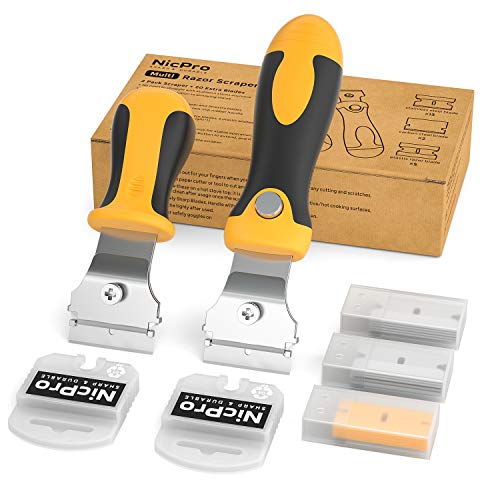
Introducing Nicpro's Pack of 2 Multi-Purpose Razor Scraper with 20 Extra Blade Refills – the ultimate removal tool for decal, sticker, vinyl glue, sealant, putty or adhesives from various surfaces such as cooktop, glass, tile, walls, floors, mirror, metal, and more.
This set includes 15 double-edged sharp razor blades, single-edged heavy-duty blades (curved*1, straight*1), and 5 plastic blades, each designed for different purposes. With a variety of blades to choose from, Nicpro's Razor Scraper is a versatile tool that can cater to all your scraping needs.
The razor scraper's comfortable ergonomic design is a standout feature. It features a zinc alloy body and handle with TPR and tough polypropylene materials that ensure the most comfortable cushioned grip, better control, and superb longevity. The adjustable handle with a 4-position manual retraction adds to the comfort and convenience of using this tool.
Safety is a top priority for Nicpro, and each scraper remover has a secure tightener knob as a razor blade holder for reinforced construction and stable operation. This feature also protects you from accidentally cutting yourself while using the tool.
Nicpro's Razor Scraper is a great investment for anyone who needs a reliable and heavy-duty scraper that can perform multiple functions. And to give you peace of mind, Nicpro offers a 100% risk-free purchase. If you are not satisfied with the utility knife set, they are happy to either provide a no-questions-asked refund or replacement.
3. Max Strip Paint & Varnish Stripper 1 Qt
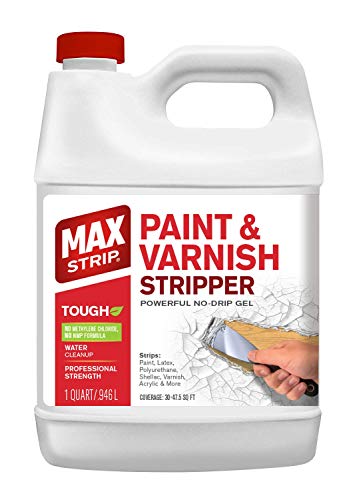
Looking for a safe and effective way to remove stubborn paint and varnish without exposing yourself to harmful chemicals? Look no further than this top-quality paint stripper! Unlike other products on the market that contain toxic substances like Methylene Chloride and NMP, this paint stripper is completely free from any harmful chemicals.
Thanks to its convenient and easy-to-use no-drip gel formula, this paint stripper is incredibly simple to apply and clean up. And because it cleans up with just water, you won't have to worry about any harsh fumes or unpleasant odors during the stripping process.
This paint stripper is also non-caustic and features a low volatile organic compound formula, making it safe and environmentally friendly. It's important to note that while this product is highly effective at removing many types of paint and varnish, it's not designed for use on deck coatings, factory finished surfaces, or baked-on coatings like vehicle paint.
If you're looking for a safe, effective, and easy-to-use paint stripper that won't expose you to harmful chemicals or harsh odors, this is the product for you! So why wait? Try it out today and see the difference for yourself!
4. Gel Strip: Small Space Paint Remover
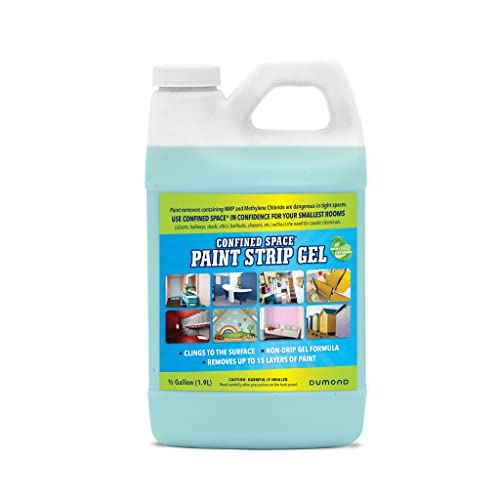
The Dumond Peel Away 1 Heavy-Duty Paint Remover is the perfect solution for DIY enthusiasts and professionals looking to remove tough, stubborn paint and coatings. This powerful formula is capable of removing up to 15 layers of acrylic, epoxy, urethane, varnish, latex, oil, and water-based paints in a single application.
One of the best features of this product is its versatility. It can be used on a wide range of surfaces including wood, brick, unpolished stone, steel, aluminum, asphalt, tile, terra cotta, granite, concrete, plaster, cast iron, cement, clapboard, and slate. This makes it an ideal choice for anyone looking to remove paint and coatings from various surfaces.
The Citrus Lime formula is highly effective in confined spaces such as closets, furniture, sheds, attics, bathtubs, showers, stairwells, and even the tiniest rooms. This means that no matter how tight the space, this product can help you get the job done quickly and easily.
Another great feature of this paint remover is that it has a water-based non-drip formula. This allows it to stick and cling to vertical surfaces without dripping, making it ideal for use in tight, enclosed spaces. Additionally, it does not contain dangerous methylene chloride or harmful NMP, making it a safer option for both the user and the environment.
Dumond Peel Away 1 Heavy-Duty Paint Remover is proudly manufactured in the USA with globally sourced, high-quality ingredients. This makes it a reliable and durable choice for anyone looking to get the job done right the first time. Whether you're a DIY enthusiast or a professional, you can trust Dumond to provide you with a high-quality product that will make your life easier. So why wait? Get your hands on this amazing paint remover today and see the results for yourself!
5. 3m Paint And Rust Stripper, 4 In. Diameter, 1 Disc/pack
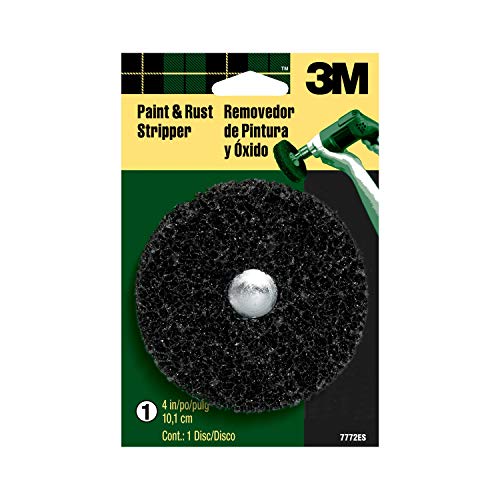
The product being reviewed is a versatile and efficient sanding disc that comes in a pack of one. This sanding disc is designed to strip quickly, cut fast, and follow the surface contours of various materials, such as wood, metal, plastic, and fiberglass.
One of the key features of this sanding disc is its ability to strip quickly. This means that with minimal effort, users can expect to remove old paint, rust, or other unwanted coatings from their materials in a timely and efficient manner. Moreover, the sanding disc cuts fast, which makes it ideal for use on materials that require quick and precise cuts.
Another great feature of this sanding disc is that it follows surface contours with ease. This means that users can sand curved or uneven surfaces without worrying about causing any damage or leaving unsightly marks. This feature is particularly useful for those who work with materials that have intricate designs or shapes.
The sanding disc is suitable for use on a wide range of materials, including wood, metal, plastic, and fiberglass. This versatility makes it a great choice for DIY enthusiasts, carpenters, and professionals who work with different materials on a regular basis.
6. Grip & Remove Damaged Bolts With Ease
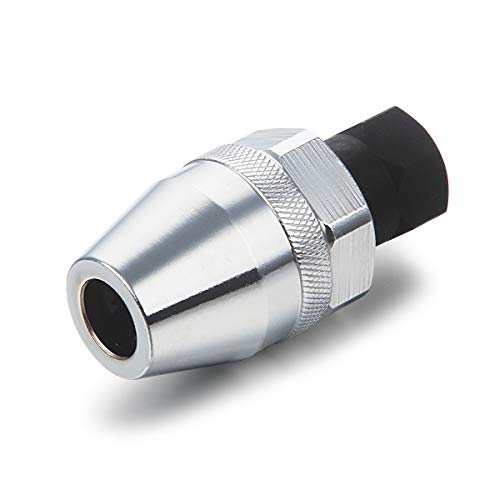
The Damaged Bolt Extractor 3/8" inch Drive is a handy tool for anyone who works with bolts frequently. This extractor tool is designed to help you easily remove damaged studs, allowing you to clamp down on them without any complications.
With its adjustable design, this extractor tool can fit studs that range from 1/4-inch to 1/2-inch (6mm to 12mm), making it a versatile addition to any toolbox. The internal 3 Jaws Design makes it easy to operate and saves you time, making your work more efficient.
Whether you're dealing with threaded, broken, rusted or stripped studs, this extractor tool will make the process of removing them a breeze. No longer will you have to struggle with stubborn bolts, as this tool will get the job done quickly and easily.
Investing in the Damaged Bolt Extractor 3/8" inch Drive is a smart choice for anyone who wants to make their work easier and more efficient. Its reliable and durable design ensures that it will last for many uses, making it a worthwhile investment for any professional or DIY enthusiast.
7. Krud Kutter Ph35/12 Waste Paint Hardener Crystals
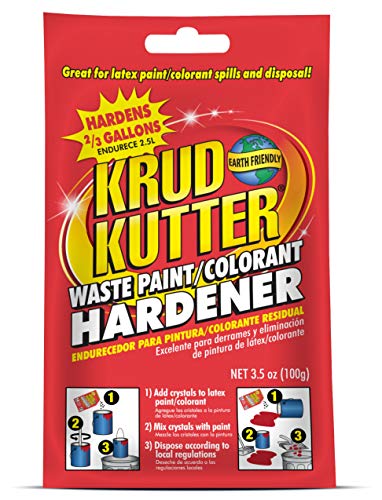
The Latex Paint Hardener is a highly efficient solution for treating 2-3 gallons of latex paint and cleaning up any accidental spills. This product is incredibly easy to use and will turn liquid latex paint into a solid form in just a matter of minutes.
Simply add the hardener to the paint, stir for a few minutes, and wait for it to solidify. Once the paint has solidified, it can be disposed of in accordance with local regulations. This product is an excellent choice for those who want to dispose of their latex paint safely and easily.
In addition to its disposal benefits, this hardener is also great for cleaning up latex paint spills. Simply sprinkle the hardener onto the spill, allow it to absorb the paint, and then sweep it up. This will help to prevent any messy and time-consuming clean-up.
8. Krud Kutter 336249 Latex Paint Remover, 24 Oz
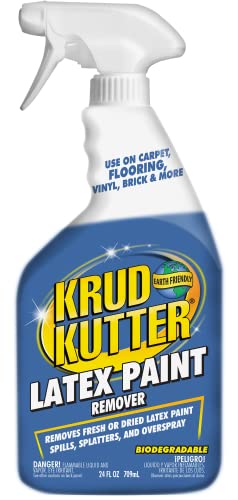
This paint remover is a versatile solution for those looking to effectively remove both fresh and dried latex paint from interior and exterior surfaces. Its biodegradable, low VOC formula ensures that it is an eco-friendly option while still maintaining its efficiency. Within minutes of application, the formula soaks into the paint and begins to loosen it, making the removal process quick and easy.
This paint remover is suitable for use on a variety of surfaces, including carpet, wood, fabric, brick, laminate, concrete, tile, vinyl, and more. It is capable of handling even fully cured latex paint spills and splatters, making it a reliable solution for both DIY enthusiasts and professionals.
However, it is important to note that this paint remover is not recommended for use on leather. To ensure optimal results, it is important to follow the instructions provided on the packaging.
9. Paint Removal Test Kit – Diy & Pro
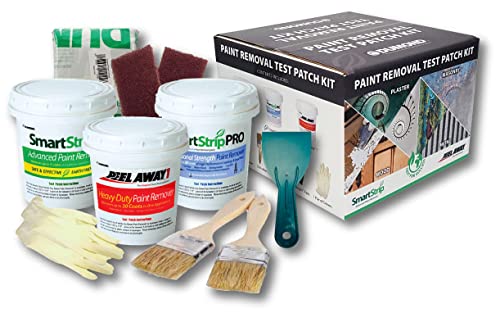
This comprehensive Test Kit is an ideal solution for identifying the right paint remover for the job at hand. It includes Smart Strip (16oz), Smart Strip Pro (16oz), Peel Away (16oz), Dumond Laminated Paper (3 Sheets), Citri-Lize Neutralizer (1oz), 1 Scraper, 2 Brushes, and 1 Pair of Gloves.
With this kit, you can easily identify the optimal paint remover to use, even when you are unsure of the specifications of the paint coating. This helps to eliminate costly guesswork and frustration.
The paint removers included in this kit are designed to work on a wide range of surfaces, including Wood, Brick, Metal, Concrete, Stone, Plaster, Fiberglass, Masonry, Tile, Porcelain, Molding, Glass, Decking, Cinderblock, and more. This makes it an essential tool for professionals, restoration experts, and homeowners alike.
These paint removers are made in the USA and have been trusted for use in hospitals, bridges, government landmarks, museums, historic buildings, opera houses, and homes worldwide. They are engineered for DIY and professional use, containing no dangerous methylene chloride or NMP.
In addition to the paint removers themselves, the kit includes a range of tools to help you get the job done. You will receive a scraper, two brushes, and a pair of gloves, as well as Dumond Laminated Paper and Citri-Lize Neutralizer (1oz).
10. Wood Renew 5753 By Deckgeneral
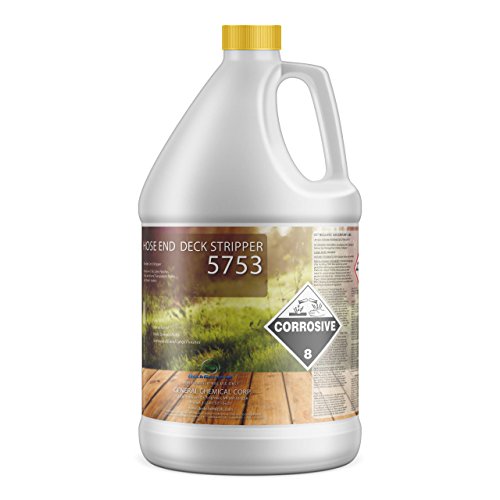
Restore the natural beauty of your wooden surfaces with the Wood Deck, Fence & Siding Restoration solution. This professional-grade formula is designed to strip away stains and discolorations, leaving your wood surfaces looking brand new. If you're planning on re-staining your wood, removing the old color is crucial for achieving a flawless finish.
This powerful deck, fence, and siding stripper effectively removes dirt, water stains, oil, latex finishes, clear and semi-transparent stains, film-forming clear coatings, water sealers, paint, deteriorated varnishes, and polyurethanes. You won't need to sand the surface in advance, saving you time and effort. This process will rejuvenate your wood and bring it back to life, making it the perfect solution for decks and fences.
Safety is a top priority, and this wood cleaner is both effective and safe to use. Unlike other deck strippers, the Deck General Varnish Remover is a unique formula that is water-based, 0 VOC, and non-corrosive. This powerful formula ensures complete cleanliness of the wood surface and easy penetration of subsequent stains, paints, or sealers.
Applying this solution is easy and straightforward. Simply pretreat the area to ensure compatibility and use the deck, fence, and siding stripper as-is. Attach a spray bottle to the end of a hose, turn on the water, spray the cleaner onto the surface, and agitate with a brush. Allow 15 to 20 minutes for the solution to react with the surface, then power wash the stripped surface to remove any traces of old material and cleaning product.
General Chemical Corp. has been solving tough cleaning problems since 1980, and their full range of premium quality, professional deck & wood cleaning products and supplies have garnered a loyal following. Many professional deck cleaning companies have switched to their non-corrosive products because of their expert cleaning results. Try DeckGeneral Varnish Remover for a reliable and effective solution to your wood restoration needs.
Best Ways To Remove Paint FAQs
Are there any natural or DIY remedies for removing paint?
Yes, there are several natural or DIY remedies for removing paint. One of the most popular methods is using vinegar. Simply heat up some vinegar and apply it to the painted surface with a cloth or brush. Let it sit for a few hours and then scrape off the paint with a scraper or putty knife.
Another method is using baking soda and boiling water. Mix baking soda with hot water to make a paste and apply it to the painted surface. Let it sit for a few minutes and then scrape off the paint with a scraper or putty knife.
You can also use a mixture of lemon juice and cream of tartar. Mix the two ingredients together to make a paste and apply it to the painted surface. Let it sit for a few hours and then scrape off the paint with a scraper or putty knife.
However, it's important to note that these methods may not work for all types of paint and surfaces. It's always best to test a small area first before applying these remedies to the entire surface. It's also important to wear gloves and protective eyewear when using these methods.
Can chemicals be used to remove paint, and if so, what should I be aware of?
Yes, chemicals can be used to remove paint from various surfaces. However, it's crucial to be aware of the potential hazards that come with using chemicals to remove paint. Chemicals used for paint removal are often toxic and can pose a serious health risk if inhaled, ingested, or come into contact with skin. Therefore, it's essential to wear protective equipment, such as gloves, eyewear, and a mask, to prevent any direct contact with the chemicals.
Moreover, it's crucial to use the right type of chemicals suitable for the surface and type of paint you want to remove. Some chemicals may damage certain surfaces, and hence it's prudent to test the chemical on a small, inconspicuous area before using it on a larger surface.
It's also essential to follow the manufacturer's instructions carefully and not leave the chemicals on for longer than recommended as this can lead to further damage to the surface. Once the paint has been removed, it's vital to clean the surface thoroughly to ensure there are no leftover chemicals that can cause further damage. Overall, while chemicals can be used for paint removal, it's essential to take all necessary precautions to ensure the safety of both you and the surface you're working on.
How can I ensure that the surface is properly prepped and ready for repainting after the paint is removed?
Proper surface preparation is crucial for a successful repainting project. Here are some steps to ensure that the surface is properly prepped and ready for repainting after the paint is removed:
1. Remove all loose paint: Use a scraper or wire brush to remove all loose paint from the surface. Make sure to wear safety goggles and a mask to protect yourself from dust and debris.
2. Clean the surface: Use a mild detergent and water to clean the surface thoroughly. Rinse with clean water and let it dry completely.
3. Sand the surface: Sand the surface with fine-grit sandpaper to remove any remaining paint and roughen the surface for better adhesion.
4. Repair any damage: If there are any holes or cracks in the surface, fill them with a patching compound and sand smooth.
5. Prime the surface: Apply a primer to the surface to ensure good adhesion and a smooth, even finish.
By following these steps, you can ensure that the surface is properly prepped and ready for repainting after the paint is removed, resulting in a beautiful and long-lasting finish.
How can I safely remove paint from delicate or intricate surfaces?
Removing paint from delicate or intricate surfaces requires patience and attention to detail to avoid causing any damage. One of the safest methods is to use a chemical paint stripper that is safe for the surface in question. It is important to choose a stripper that is compatible with the material of the surface and to read the instructions carefully before use.
Another option is to use a heat gun to soften the paint and then gently scrape it off with a plastic scraper or putty knife. This method requires caution and a steady hand to avoid overheating the surface or causing any damage.
For particularly intricate surfaces, it may be necessary to use a small brush or toothbrush to carefully apply the stripper or other removal solution to the affected area. It is important to work slowly and methodically, taking breaks as needed to avoid fatigue or mistakes.
Overall, the key to safely removing paint from delicate or intricate surfaces is to approach the task with care and patience, using the appropriate tools and methods for the specific surface in question.
How do I know if I need to use a paint stripper or a heat gun to remove paint?
The choice between using a paint stripper or a heat gun to remove paint depends on a few factors. Firstly, you need to consider the type of surface you are working on. Paint strippers are most effective on flat surfaces, while heat guns work best on intricate surfaces or surfaces with a lot of curves and corners. Secondly, you need to consider the type of paint you are trying to remove. Heat guns work best on latex paint, while paint strippers are more effective on oil-based paint.
Another factor to consider is safety. Paint strippers often contain harsh chemicals that can be harmful if inhaled or come into contact with skin. In contrast, heat guns can be dangerous if not used properly, as they can start fires or burn the user.
In summary, if you are working on a flat surface and need to remove oil-based paint, a paint stripper may be the best option. If you are working on a surface with intricate details or curves and need to remove latex paint, a heat gun may be more effective. It's important to weigh the pros and cons of each method and prioritize safety when making your decision.
Is sanding an effective method for removing paint, and what type of sandpaper should I use?
Sanding is a common method used for removing paint, but its effectiveness largely depends on the type of paint and surface you are working with. Sanding can be effective for removing layers of paint that are chipping or peeling, but it may not be as effective for removing paint that is still adhered firmly to the surface.
When it comes to sandpaper, the type you should use will depend on the surface you are working with and the level of abrasion needed. For example, if you are working on a delicate surface like wood, you may want to use a finer grit sandpaper such as 220 grit. If you are working on a tougher surface like metal, you may want to use a coarser grit such as 80 grit.
It's important to note that sanding can be time-consuming and messy, and it can also create a lot of dust. It's important to take proper safety measures such as wearing a mask and eye protection. In some cases, using a chemical paint stripper may be a more effective and efficient method for removing paint.
What are the most effective methods for removing paint from a surface?
There are several effective methods for removing paint from a surface, depending on the type of paint and the material of the surface. One of the most common methods is using a paint stripper, which is a chemical solution that breaks down the paint and makes it easier to remove. However, it is important to follow the instructions carefully and wear protective gear when using a paint stripper.
Another method is using a heat gun, which applies heat to the paint and softens it, allowing it to be scraped off. This method is more suitable for small areas or delicate surfaces, as excessive heat can damage some materials.
For outdoor surfaces, pressure washing can be an effective way to remove paint. This method uses high-pressure water to blast away the paint, but it can also damage some surfaces if the pressure is too high.
Finally, sanding can also be used to remove paint, especially for wooden surfaces. However, it requires more time and effort compared to the other methods, and it can generate a lot of dust, so it is important to wear a mask and protective gear.
Overall, the most effective method for removing paint depends on the specific situation and the type of surface, so it is important to choose the method that is most appropriate and safe.
What is the best way to remove paint from wood surfaces?
Removing paint from wood surfaces can be a challenging task, but there are several effective methods that you can use. One of the most popular ways is by using a chemical paint stripper. You can apply the stripper to the painted surface and allow it to sit for the recommended time. Then, use a scraper or wire brush to remove the paint.
Another method is by using a heat gun. This involves heating the painted surface with a heat gun until the paint softens, and then using a scraper to remove it. Be careful when using a heat gun, as it can damage the wood if you hold it in one place for too long.
Another effective way to remove paint from wood surfaces is by sanding. This method involves using sandpaper to remove the paint, starting with a coarse grit and gradually moving to a finer grit until the surface is smooth.
Whichever method you choose, make sure to wear protective gear such as gloves and a mask to avoid inhaling fumes or getting chemicals on your skin. Additionally, make sure to properly dispose of any chemicals or materials used in the process.
What precautions should I take when removing lead-based paint?
Removing lead-based paint can be hazardous if proper precautions are not taken. Here are some essential precautions to take:
1. Wear protective clothing: Wear disposable coveralls, gloves, and shoe covers to prevent lead dust from spreading to other parts of the house or on your body.
2. Use a respirator: Wear a respirator to avoid inhaling lead dust. Select a respirator that is both NIOSH-approved and designed to filter out lead particles.
3. Keep the work area contained: Seal off the area where you're working with plastic sheeting and tape to keep lead dust from spreading to other parts of the house.
4. Wet the paint: Before sanding or scraping, wet the surface of the paint with a spray bottle or wet rag to minimize the amount of dust created.
5. Use a HEPA vacuum: Use a high-efficiency particulate air (HEPA) vacuum to clean up any dust or debris.
6. Dispose of waste properly: Double bag all waste and dispose of it in accordance with local regulations.
By taking these precautions, you can safely remove lead-based paint from your home without exposing yourself or your family to the harmful effects of lead.
What tools do I need to remove paint from a surface?
Removing paint from a surface can be a daunting task, but with the right tools, it can be done with ease. Firstly, you will need safety equipment such as gloves, goggles, and a face mask to protect yourself from any harmful chemicals or debris that may be released during the process. Secondly, you will need a scraper or putty knife to remove any loose or chipped paint. A heat gun or a chemical paint stripper can also be used to soften the paint and make it easier to remove. Sandpaper or a sanding block can be used to smooth out any rough spots or remaining paint. A wire brush can be used to remove any remaining paint or debris from small crevices or corners. Lastly, a cleaning solution such as soap and water or a degreaser can be used to clean the surface after the paint has been removed. With these tools, you can effectively remove paint from any surface and prepare it for a fresh coat of paint or a new finish.
